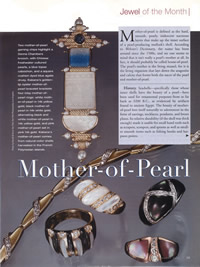
| | Mother-of-pearl is defined as the hard, smooth, pearly, iridescent nacreous layers that make up the inner surface of a pearl-producing mollusk’s shell. According to Websterís Dictionary, the name has been around since the 1500s, and no one seems to mind that it isnít really a pearlís mother at all. In fact, it should probably be called house-of-pearl. The pearlís mother is the living mussel, for it is the living organism that lays down the aragonite and calcite that forms both the nacre of the pearl and mother-of-pearl.
History. Seashells---specifically those whose inner shells have the beauty of a pearl---have been used for ornamental purposes from as far back as 3200 B.C., as evidenced by artifacts found in ancient Egypt. The beauty of mother-of-pearl lent itself naturally to adornment in the form of earrings, necklaces, pendants, and breast plates. Its relative durability (if the shell was thick enough) made it usable for small hand tools such as scrapers, scoopers, and spoons as well as smaller smooth items such as fishing hooks and harpoon points.
Jewel of the Month JCK January 2003
 |

